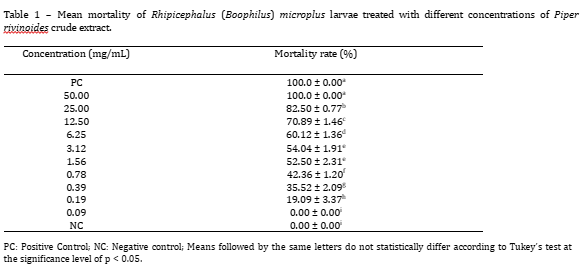Effect of Piper rivinoides extract on the control of Rhipicephalus (Boophilus) microplus
DOI :
https://doi.org/10.21708/avb.2024.18.4.12555Résumé
Rhipicephalus (Boophilus) microplus, is a major economic problem to the livestock industry, particularly as this ectoparasite is becoming resistant to conventional pesticides. Plant extracts, such as those obtained from species of the Piperaceae family, have been used as a natural alternative to control ectoparasites. This study aimed to evaluate the acaricidal and larvicidal action of Piper rivinoides extract. In the adult immersion test (AIT), P. rivinoides extract was tested at concentrations of 5-50 mg/mL, while for the LPT the extract was tested at concentrations of 0.09-50 mg/mL, and in the ex situ test in an open environment, the P. rivinoides extract was tested at a concentration of 6.12 mg/mL, using as a positive control a solution containing 150 μg/mL of cypermethrin, 250 μg/mL of chlorpyrifos and 10 μg/mL of citronellal, and 2% ethanolic aqueous solution was used as a negative control. Data were analyzed with the Tukey test using one-way analysis of variance (ANOVA) and the lethal concentrations were calculated by Probit analysis. The P. rivinoides extract in LPT eliminated 100% of larvae at 50 mg/mL after 24 h at 27–28°C. The extract was also effective at the same concentration, killing 100% of engorged female ticks in AIT. Furthermore, in an open environment under semi-natural conditions ex situ, the P. rivinoides extract (6.12 mg/mL) had 73.79% efficiency against cattle tick larvae. These results demonstrate the potential acaricidal activity of P. rivinoides extract, presenting as a potential natural alternative to combat ectoparasites.
Téléchargements

Téléchargements
Publié-e
Numéro
Rubrique
Licence
(c) Tous droits réservés Acta Veterinaria Brasilica 2024

Cette œuvre est sous licence Creative Commons Attribution 4.0 International.
Autores que publicam na Acta Veterinaria Brasilica concordam com os seguintes termos: a) Autores mantém os direitos autorais e concedem à revista o direito de primeira publicação, com o trabalho simultaneamente licenciado sob a Licença Creative Commons Attribution que permite o compartilhamento do trabalho com reconhecimento da autoria e publicação inicial nesta revista. b) Autores têm autorização para assumir contratos adicionais separadamente, para distribuição não-exclusiva da versão do trabalho publicada nesta revista (ex.: publicar em repositório institucional ou como capítulo de livro), com reconhecimento de autoria e publicação inicial nesta revista. c) Autores têm permissão e são estimulados a publicar e distribuir seu trabalho online (ex.: em repositórios institucionais ou na sua página pessoal) a qualquer ponto antes ou durante o processo editorial, já que isso pode gerar alterações produtivas, bem como aumentar o impacto e a citação do trabalho publicado (Veja O Efeito do Acesso Livre).


 Esta obra está licenciada com uma Licença
Esta obra está licenciada com uma Licença 